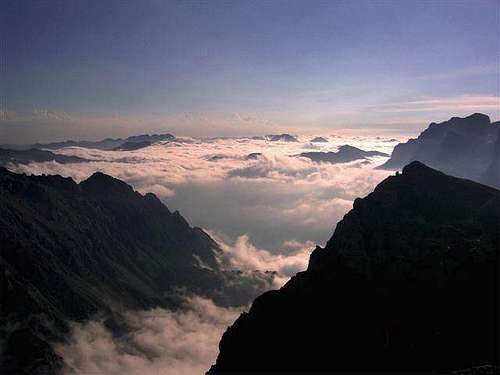|
|
Mountain/Rock |
|---|---|
|
|
43.15840°N / 4.8741°W |
|
|
8021 ft / 2445 m |
|
|
Overview
PrefaceI´d like to thank SP Community the good words about this page. It was not easy for me, maybe the most difficult page I made.
Plese, if anyone has any information that could improve the page just let me know.
Your help is wellcome.
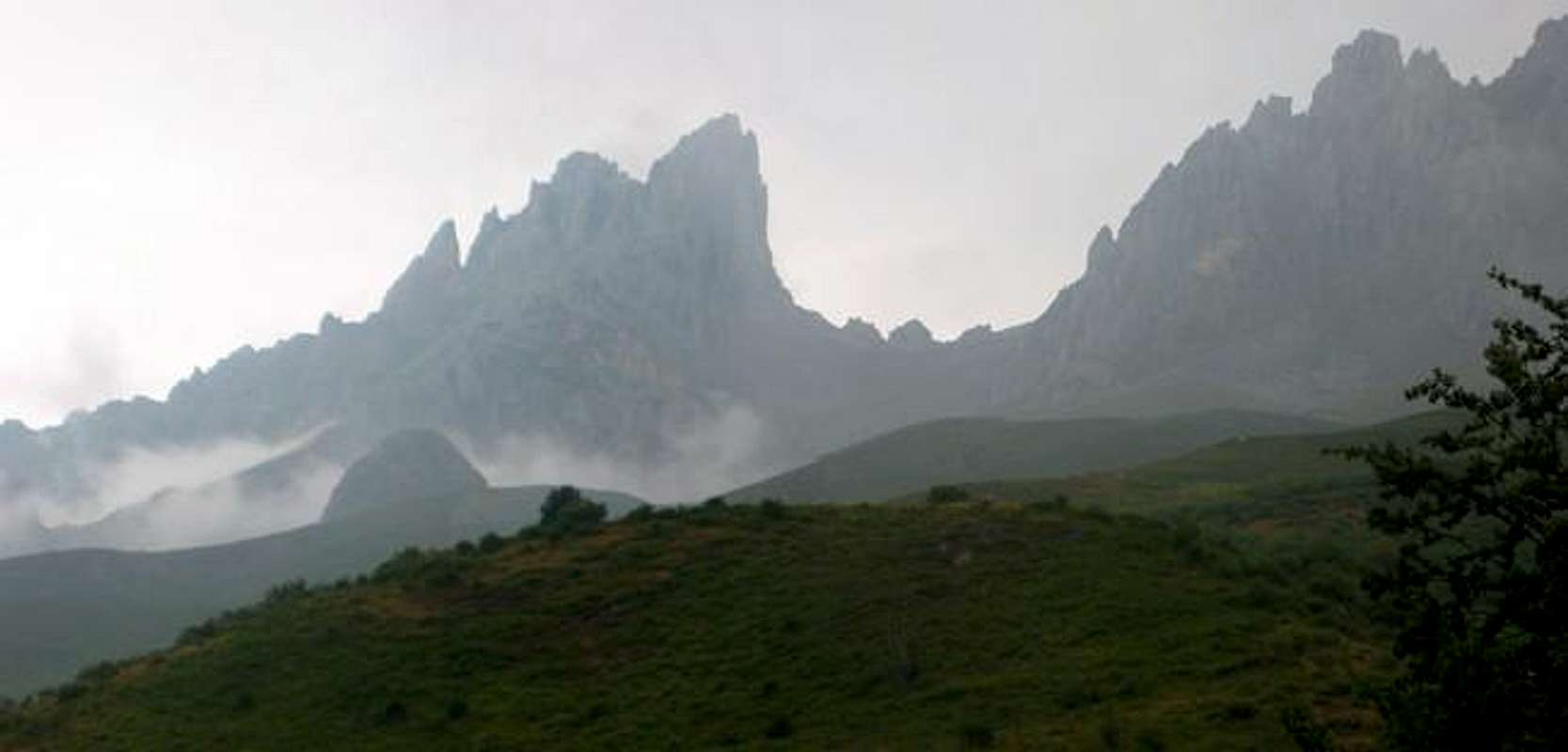
One of the most well known and climbed peaks of Picos de Europa, Torre del Frierro, or just Friero, is really an impresive and representative mountain of León province and Cordillera Cantábrica. It has a great record: its two long North corridors are the longest in Spain. (According to the Spanish SP guru Rafa Bartolome it has 900 m high, level D)
The peak belongs to Central massif of Picos de Europa, also know as Urrieles. Reasonablely tall, sheer and slim is a good challenge for medium and high level mountainers and climbers. As a Picos de Europa peak it is extremelly dangerous with fog, only for veterans and experts on winter. The main advantage of Friero is it´s not neccesary to spend hours walking to aproach it so you can get the summit in just some hours (some peaks around take you at least a day... or more).
The other advantage is plenty of different routes of very different levels. I heard it´s a very good place for ice-fall climbers.
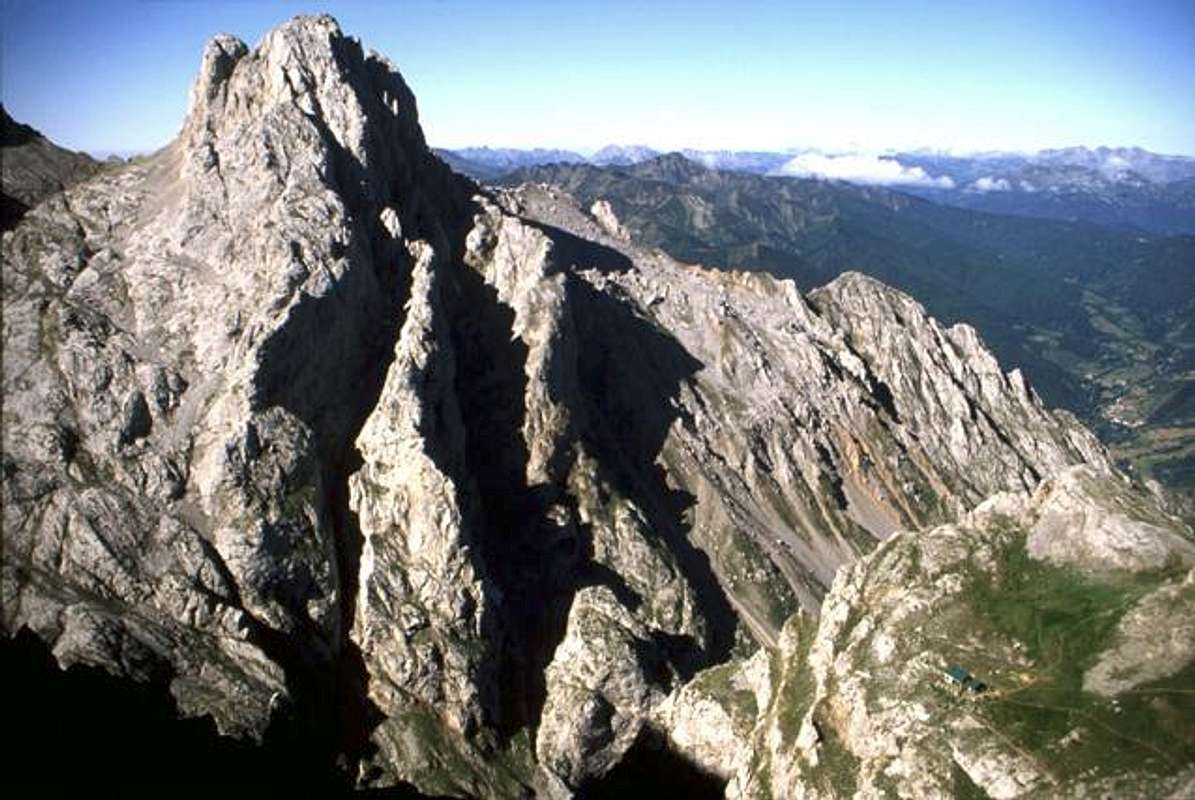
Thanks for the marvellous pictures of North face, by ppatenall
Getting There
You can use public transport, as a coach, but it´s better if you use your own car. Using public transport could increase the number of hours of the route.In any case, you need to go to Valdeón Valley area, one of the most beautifull valleys on the Picos de Europa heart.
a) From León:
- N-601 to Mansilla de las Mulas, in the crossroad, left to N-625.
- N-630 to La Robla, turning right to C-626 to Boñar. There take the road to Sabero. You´ll
get the crossroad with N-625. Turn left to the North.
Using both options you can go towards Riaño. Leave Riaño on your back. In the interjection
you can choose taking the road to Puerto del Pontón N-625 or the other one N-621 to Puerto San Glorio:
- The first option will take you near the Pontón pass, where you have to take a road on your right hand towards Puerto de Panderrueda (LE-244). Go down to Posada the Valdeón.
- The second one is usefull two, depending the route you choose. Taking the N-621 you´ll find a road on your left LE-243 towards Puerto de Pandetrave. It will take you to Posada de Valdeón.
b) From Asturias:
You have four mountain-passes to cross the mountains driving. From West to East:
- Puerto de Pajares N-630: go to La Robla and then the same as I described for coming from
León.
- Puerto de San Isidro LE-333: go to Boñar and just the same.
- Puerto de Tarna C-635: turn left into N-625
- Puerto del Pontón N-625: turn left into LE-244.
c) From Santander:
-Puerto de San Glorio N-621: just before Llánaves de la Reina take an interjection on your right, LE-243.
d) From Palencia:
Take C-615 crossing Puerto Las Portillas. In León province take LE-241 going through Puerto de Los Picones.Don´t take Puerto de Monteviejo road is not very well. You´ll arrive at Boca de Huérgano. Take here N-621 towards Riaño. From here you can use the previous explanation.
Road map:
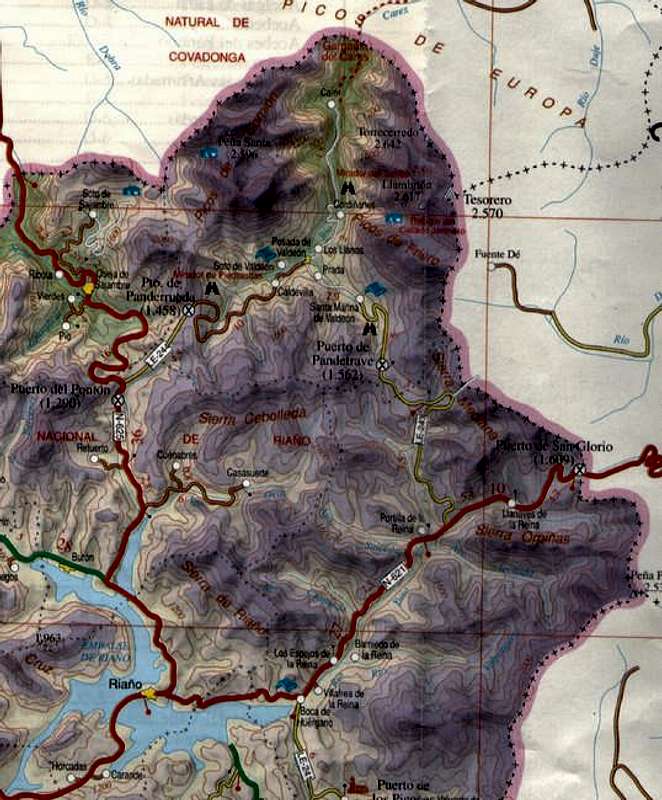
(Click on the map to make it bigger)
You can also have a look here:
Michelin Guide road map (English) | Michelin Guide road map (Spanish)
Red Tape
As in other mountains in León province there´s nothing special to say about. No wild dangerous animals known. No fees.PLEASE: Keep the environment clean. Keep in mind is a protected area.
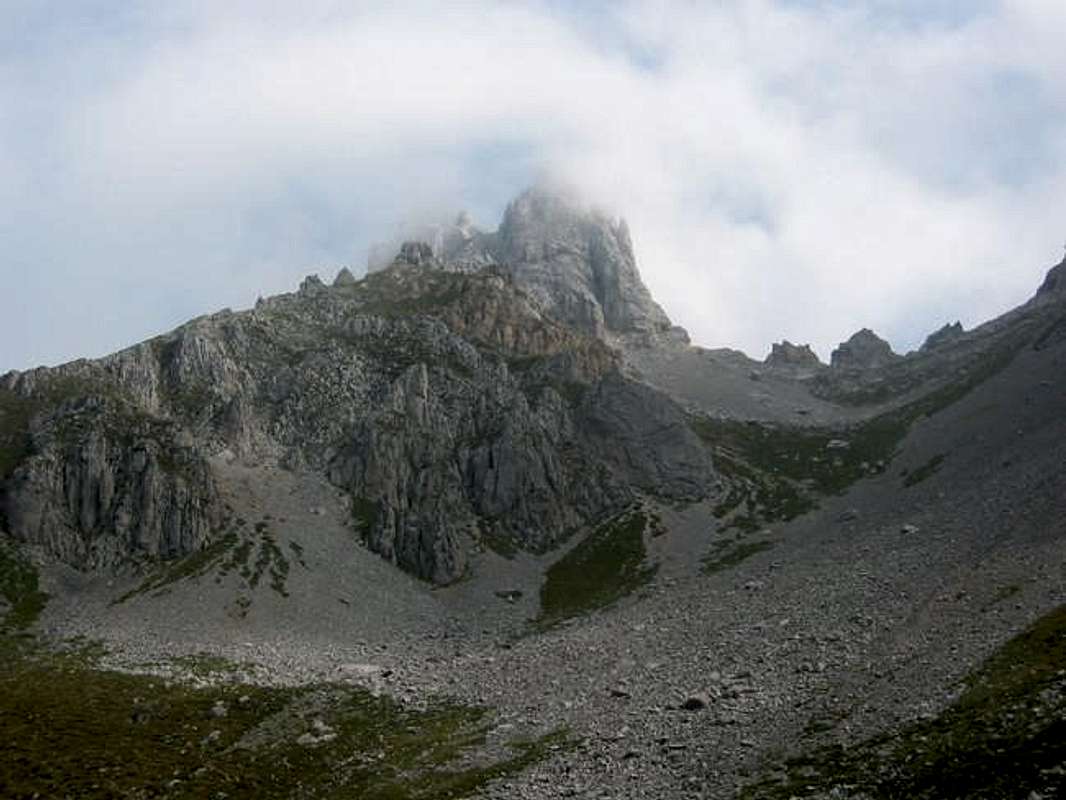
When To Climb
My short experiencie there was on summer, a cloudy hot day that became a stormy and rainy day. Have a look carefully at the weather forecast.Don´t try to climb Friero on winter if you aren´t a well experienced climber.
Select carefully the date, according with the weather forecast.
The best period to climb Torre del Friero is probably the summer, despite the hot temperatures. If you are lucky you can have a not very hot sunny day.
Camping
Camp is not allowed in León province, except private camp sites.You have many possibilities of accomodation in the area.
You´ll find private camp sites not far from Torre del Friero.
Also, there is a refuge on the mountains on Collado Jermoso area. In fact, from this point there is a lovely view of the Friero.
Mountain Conditions
The weather here changes quickly because the sea is not far on the North. Storms and wet winds reach these mountains in just some hours making storms with snow, heavy rain, thunders or just the dangerous fog. Even really good climbers using sofisticated GPS equipement could have serios problems were the fog comes from the sea.The temperatures in this area are really low most of the year. On summer Picos de Europa is hard because temperatures can reach 30º and there is no way to find water in these mountains.
Also, on winter there is the risk of avalanches. The quantity of snow it´s huge some years, so be carefull. As an example there are places on Torre del Friero where it´s possible to find snow on summer.
Weather forecast:
[ Left ] Metosat satellite view provided by INM - www.inm.es -
* Note: the map shows the clouds evolution.
[ Right ] Reflectivity map provided by The Weather Channel - www.weather.com -
* Note: the map shows, from blue to red, the power of clouds.
 |  |
For more info use these links: Weather forecast today (English) | Weather forecast today (Spanish)
Note:Riaño is the bigest village around. It can give you an idea, but it´s not enough to know what is the wheather like on Picos de Europa. The weathe could be good on Riaño and terrible on Picos, or just the opposite.
Picos de Europa weather forecast information on www.picoseuropa.net
My Suggestions
* Walk slowly. The slopes in Picos de Europa are really long and hard.* Taste the Posada de Valdeón traditional cheese.
* Visit "Chorco de los lobos" and "Ermita de La Corona" not far from Cordiñanes.
VERY IMPORTANT:
** Take a MOBILE PHONE with you. You can use it most of the mountain areas. If you can phone try going up or changing your position. I can remember my mobile ringing on the summit of Torre de Friero... I couldn´t believe it! Mobile is the best thing to make an emergency call. Forget about radios.
Take note of this number: 987 718 004. It´s the number of G.R.E.I.M., Guardia Civil Mountain Rescue Team. They are really good proffessionals with lots of years of experience. If you have serious problems phone them: tell them who you are, how many people is in difficulties, try to tell them where you are, or at least a detailed description of the area.
Special info
The meaning in English of some Spanish words.-------------------------------------------------------------------------
* Collado, collada: col, for instance "Collado de Gete"
* Pico: peak, for instance "Pico Fontún"
* Peña: peak (very tipical from León, Asturias, Santander), for instance "Peña Ten"
* Torre: peak (very tipical from León, Asturias, Santander), for instance "Torre del Friero"
* Cueto: peak, for instance "Cueto Millaró"
* Puerto: mountain pass, for instance "Puerto de Pajares"
* Cordillera: big group of mountains, for instance "Cordillera Cantábrica"
* Macizo: group of some mountains or peaks, massif, for instance "Macizo Central, Urrieles of Picos de Europa"
* Cumbre: summit
* Cima: summit
* Canal: corridor, for intance "La Canal de Dobresengos", note it´s in femenine
* Canaleta: narrow corridor
* Hoces: canyon made by a river, for instance "Hoces de Vegacervera", "Hoces de Valdejeja"
* Valle: valley, for intance "Valle de Valdeón"
* Río: river, for instance "Río Torío"
* Horcado: narrow col between two peak, normally difficult to cross, for intance "Horcado de Pambuches"
Books I recomend.
-------------------------------------------------------------------------
Montañas de León (in Spanish only)
Ramón Lozano, Santiago Morán
Everest Editorial
ISBN 84-241-0404-8
Description in detail of more than one hundred routes across the mountain of the León province, including the Picos de Europa Area and many others.
Book details (English) | Book details (Spanish)
Picos de Europa (in Spanish only)
Bernardo Canga, Carmen Piñán
Editorial Everest
ISBN 84-241-0065-4
A journey guide, not technical at all, but useful if you want to know the area and something else about culture and people and animal who lived there.
Book details (English) | Book details (Spanish)
50 montañas de la Cordillera Cantábrica (in Spanish only)
David Atela
Desnivel Ediciones
ISBN 84-96192-90-3
Really useful book about the most remarkable mountains in Cordillera Cantábrica massif. It doesn´t containt anything about Picos de Europa area so it lets it go along another interesnting and no so famous mountains.
Book details (Spanish)
Another remarkable peaks in the area
* Peña Santa - 2596 m* Llambrión - 2642 m
* Torre Cerredo - 2648 m
* Peña Vieja - 2648 m
* Peña Castil - 2444 m
* Jultayo - 1940 m
* Urriellu / Naranjo de Bulnes - 2519 m
* Peña Prieta - 2575 m
* Curavacas - 2525 m
For extra info about Picos de Europa massif visit Picos de Europa GROUP
I enclose a really intersesting external link (available only in Spanish): www.picoseuropa.net
The Spanish corner :-)
Info in Spanish for Spanish Speakers & Spanish Studients:Para todos aquellos que no tengan un inglés súper, y yo me incluyo, he decidido añadir esta sección. También para todos aquellos que estudian o están aprendiendo español.
¿Qué podría yo decir del Friero? Mis impresiones in situ, las que recuerdo (tal vez infantiles) pueden ilustrar mi idea de ese monte: grande, aéreo, rocoso.
Las dimensiones de las cumbres de esta zona no tienen parangón en toda la Cordillera. No es una cuestión de altura, es más una cuestión de desnivel y volumen en metros cúbicos. Estas montañas son muchísimo más grandes. Son muy "aéreas"... los desniveles son grandes, jalonados de grandes pendientes... todo es más grande incluidos los enormes vacíos. Y rocoso, sí rocoso. A veces es dificil encontrar otra cosa. Las cumbres de Picos son grandes desiertos de piedra, de una aridez grisácea indescriptible.
Como digo en el prefacio no soy un gran montañero y tal vez no sea siquiera un montañero ni siquiera. Y la razón es que montañas como esta marcan esa diferencia. En mi caso creo que el Friero podría ser mi límite. Eso es lo hermoso, quizá sea uno de esos pocos lugares donde quien más o quien menos pueda encontrar el suyo... o enfrentarse con sus dudas y sus temores.
Para una información más detallada os remito al texto en inglés. Si tuviéseis algún problema estoy a vuestra disposición para facilitaros toda la información que esté a mi alcance.
Photos: external links
As you can see I don´t have yet a lot of photos of this mountain, so I suggest to see this pictures below that belong to other web sites.From www.colladojermoso.com Norh Face of Friero and Collado Jermoso refuge
From www.colladojermoso.com Norh Face of Friero on winter
From Barrabes: Incredible document about the Norh corridor of Friero
From www.picoseuropa.net Norh Face of Friero on winter
From www.picoseuropa.net Norh Face of Friero on winter, other good pic
From www.picoseuropa.net Norh Face of Friero
Special thanks
* Luis, gracias por hacerlo posible (Luis thanks for make it possible).* A todos mis amigos del Corte Inglés de Callao, por ayudarme entonces con el Friero de cada día (My friends of Callao Corte Inglés, for helping me in my everyday Friero peak).









